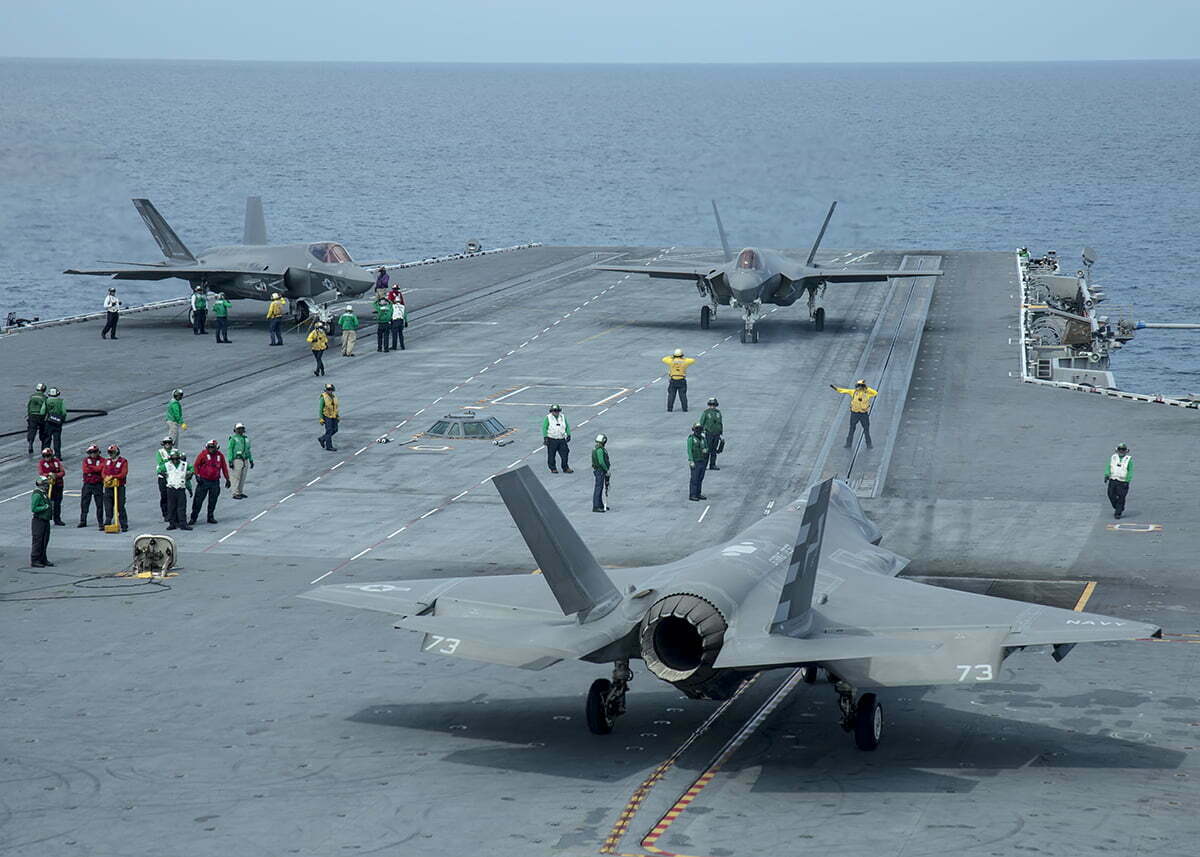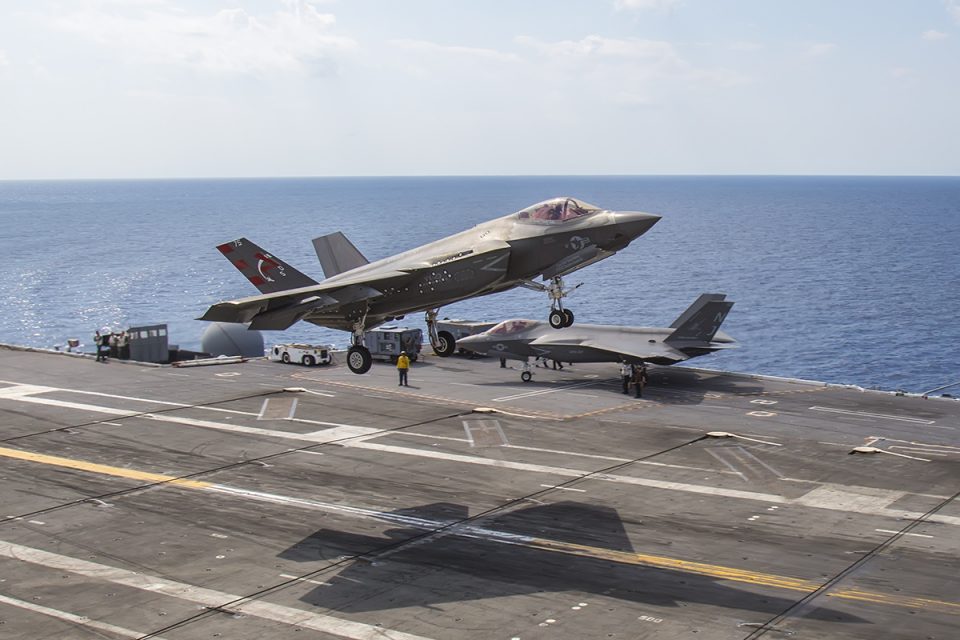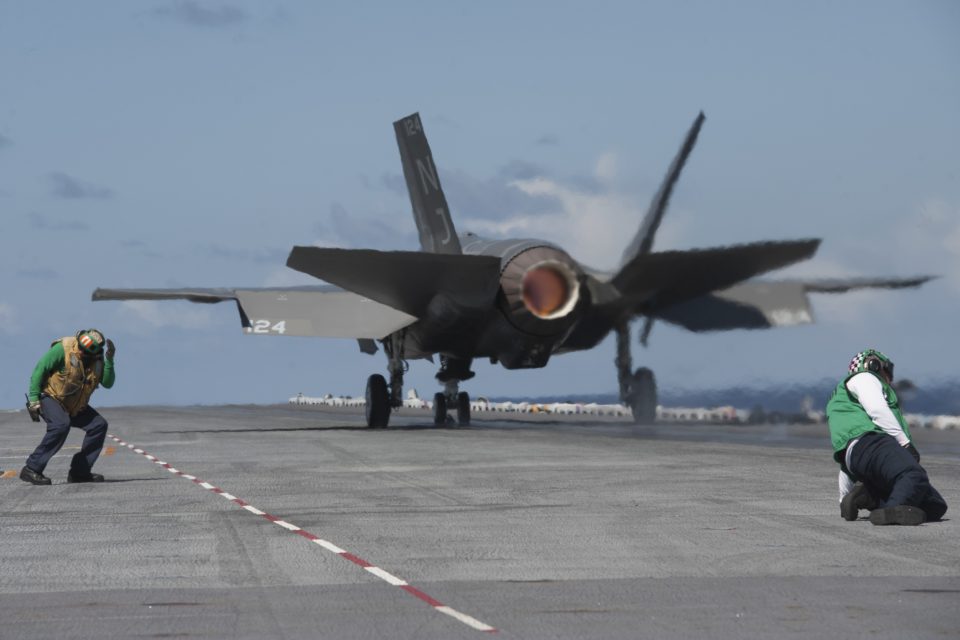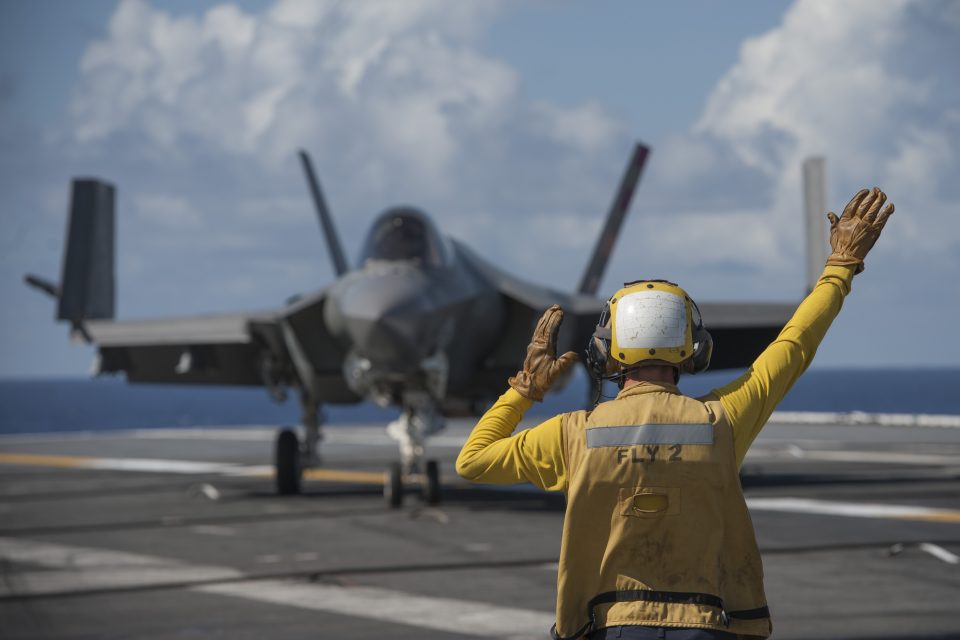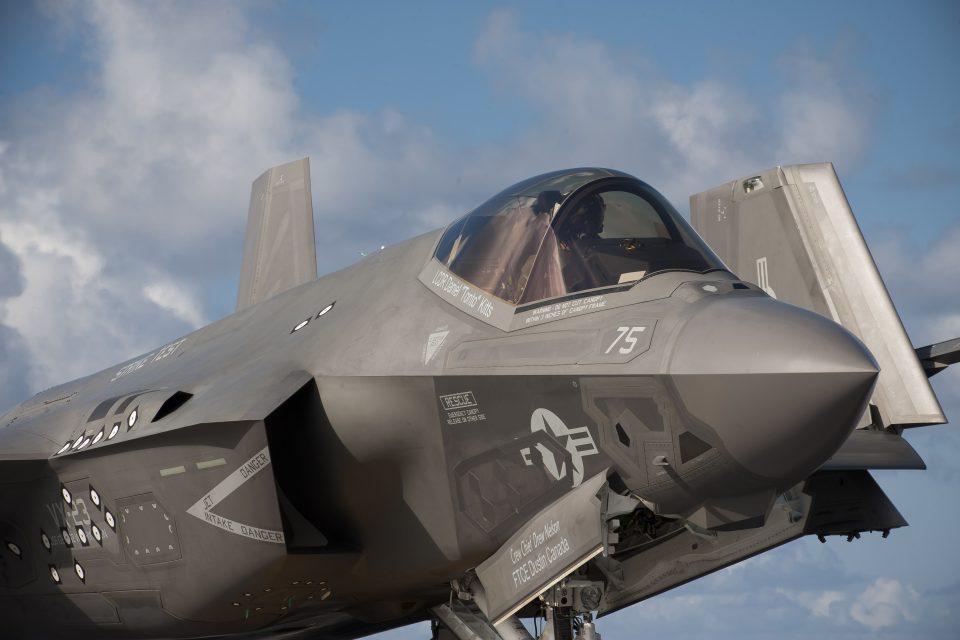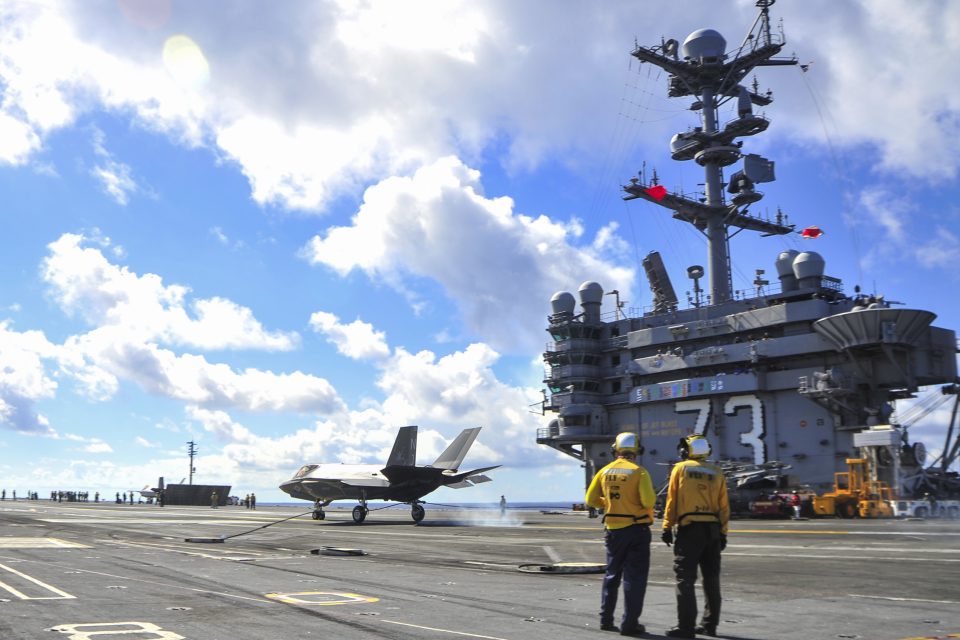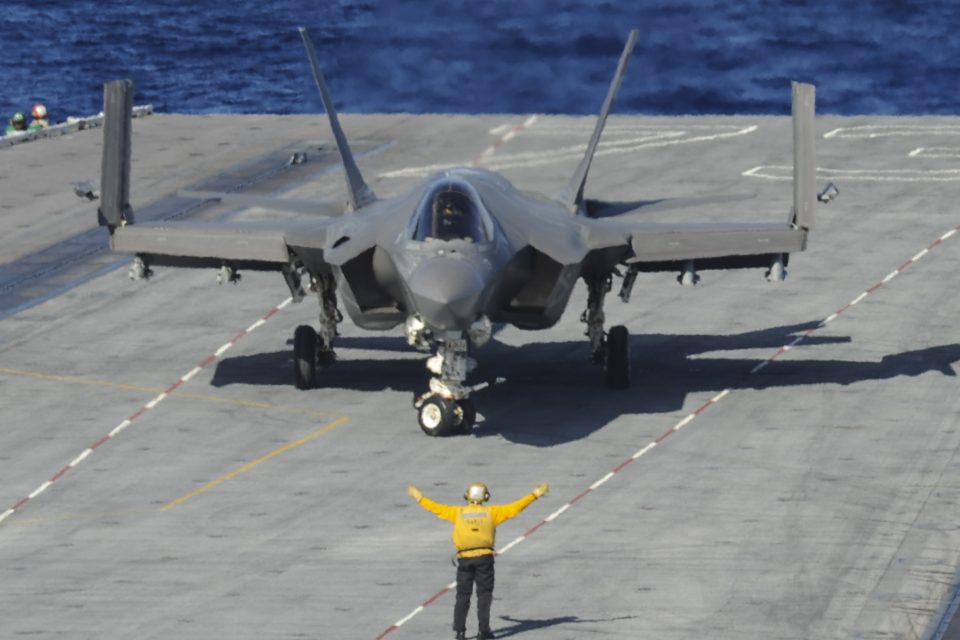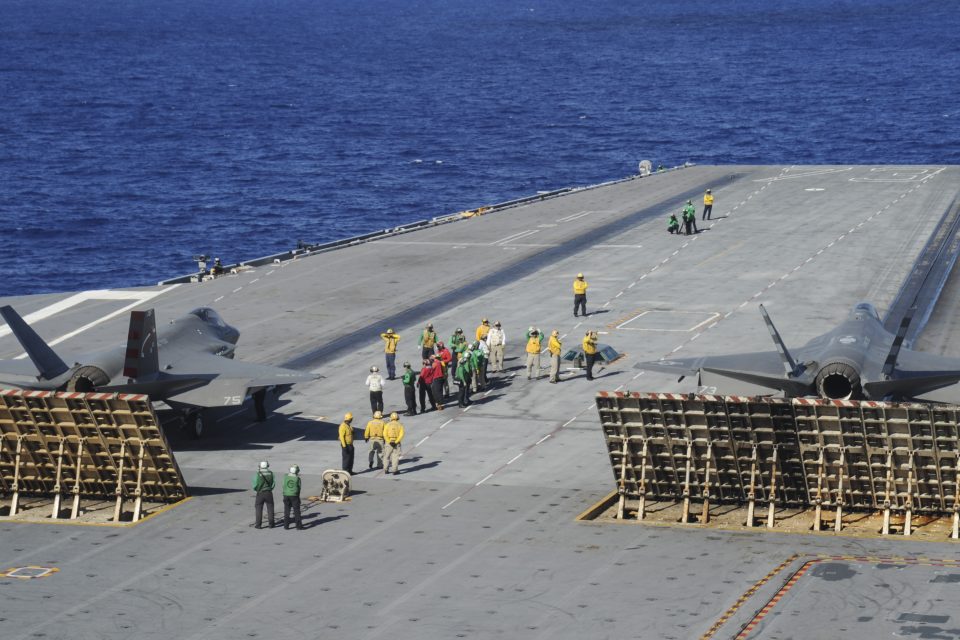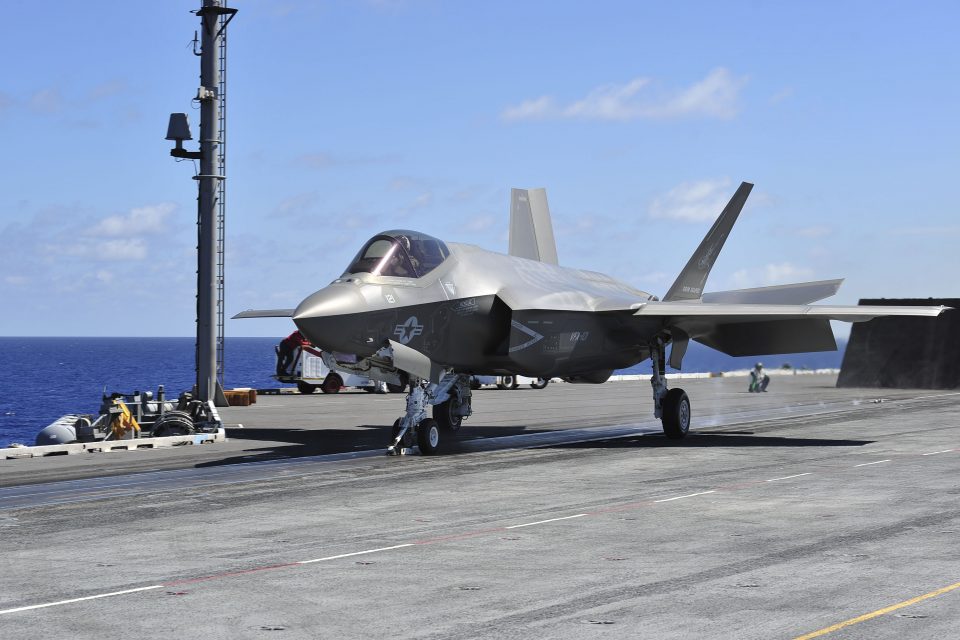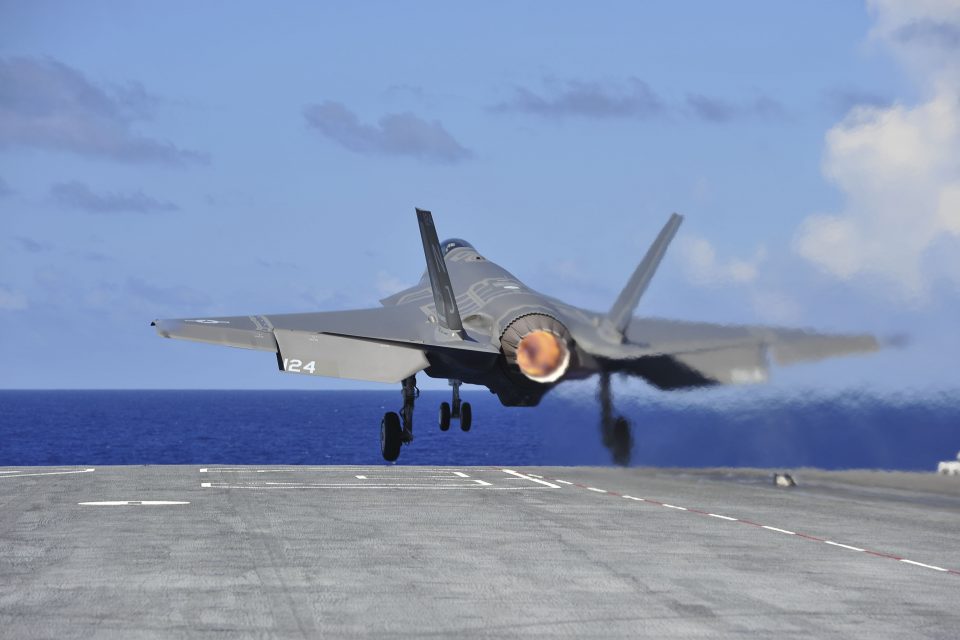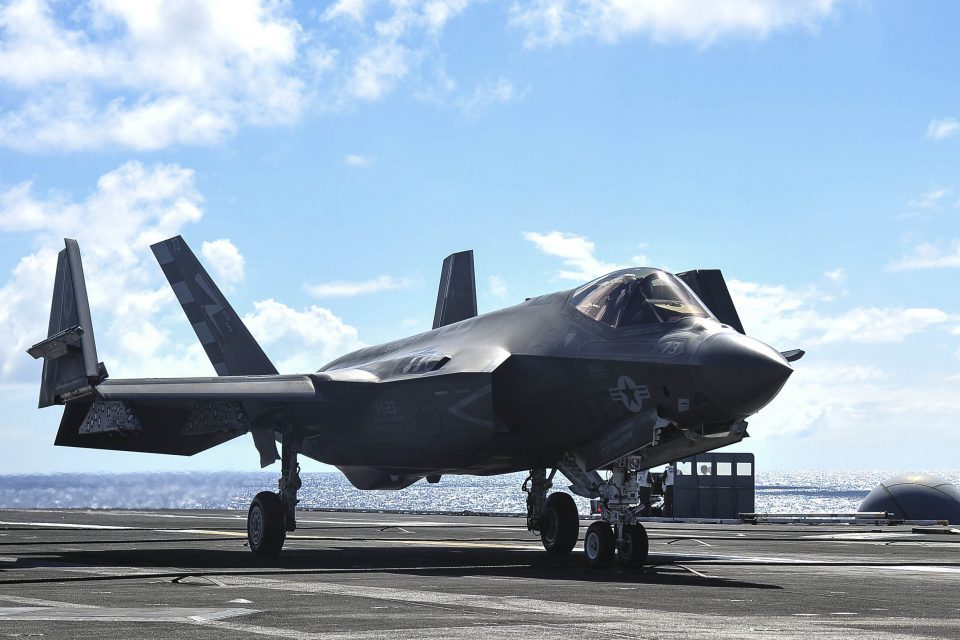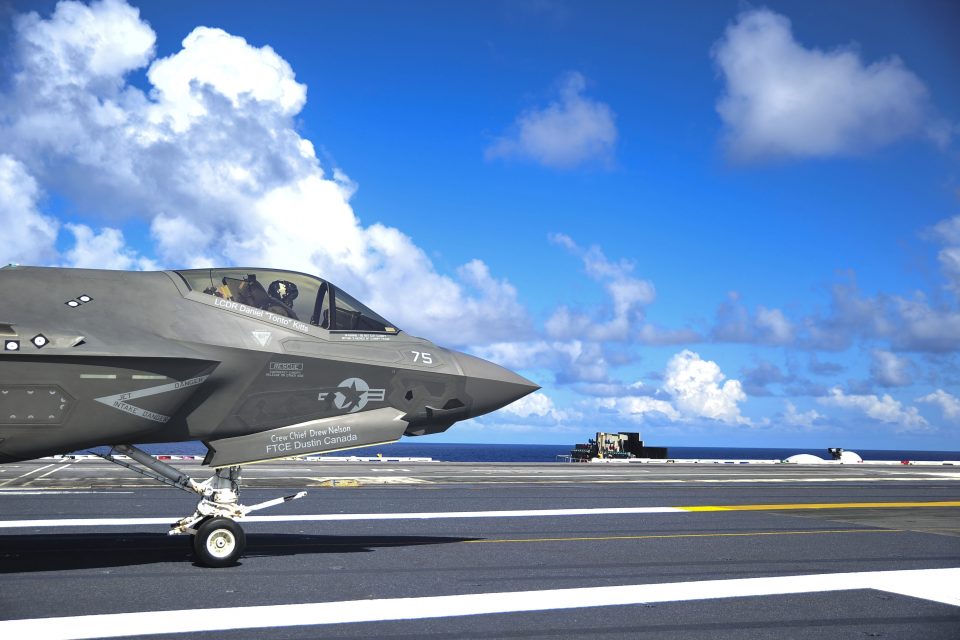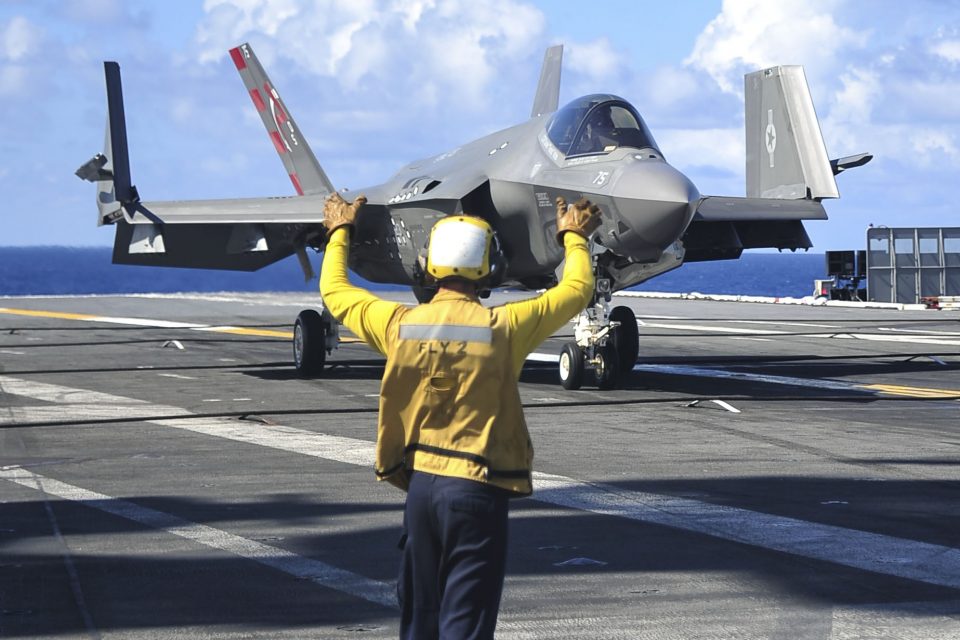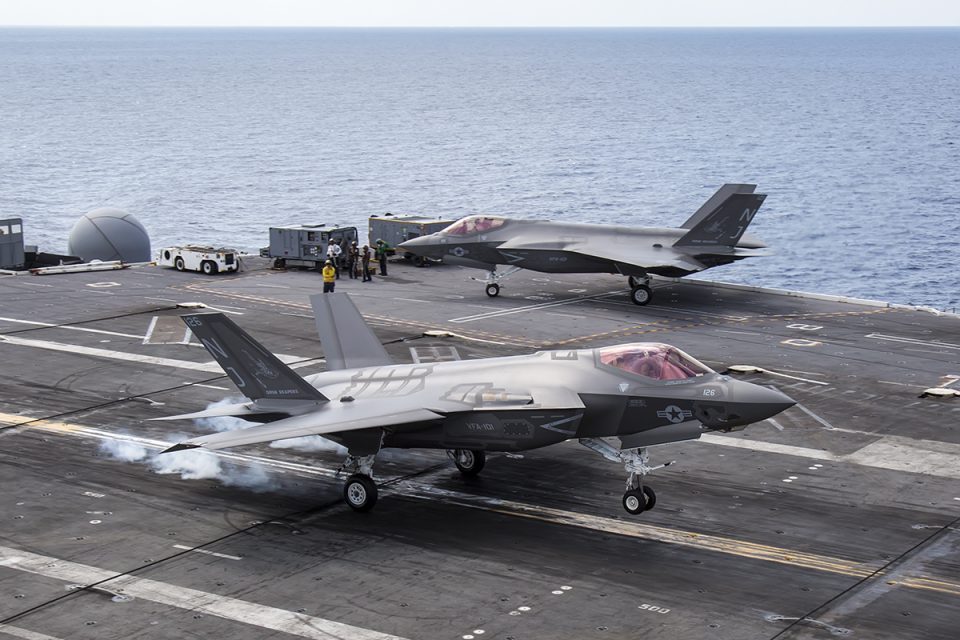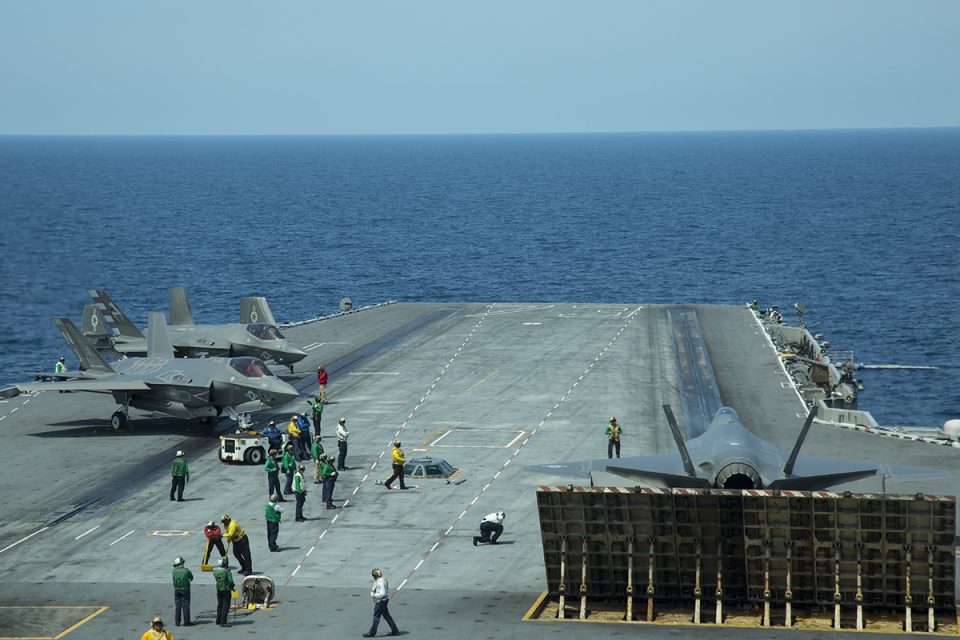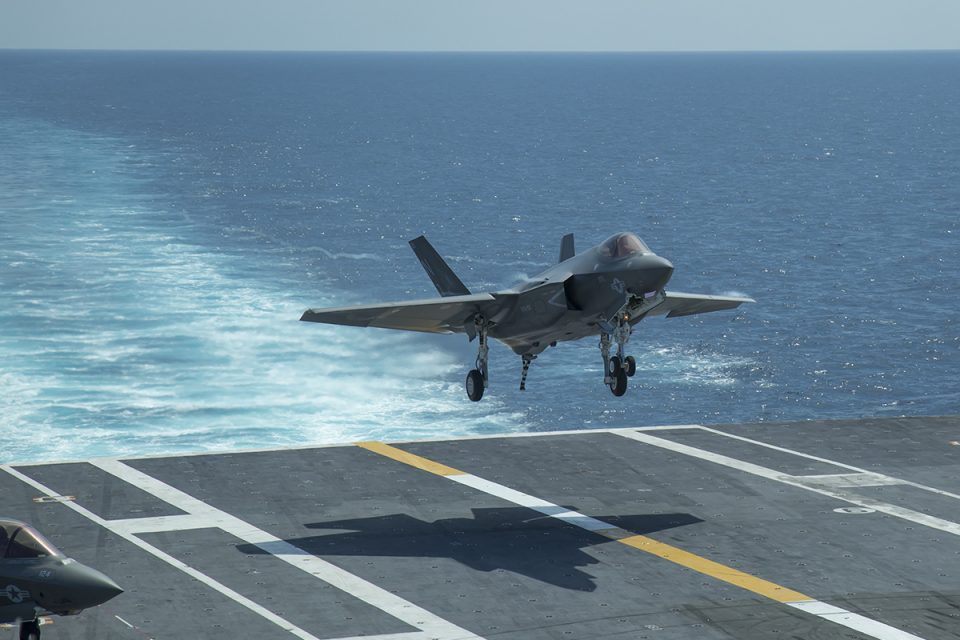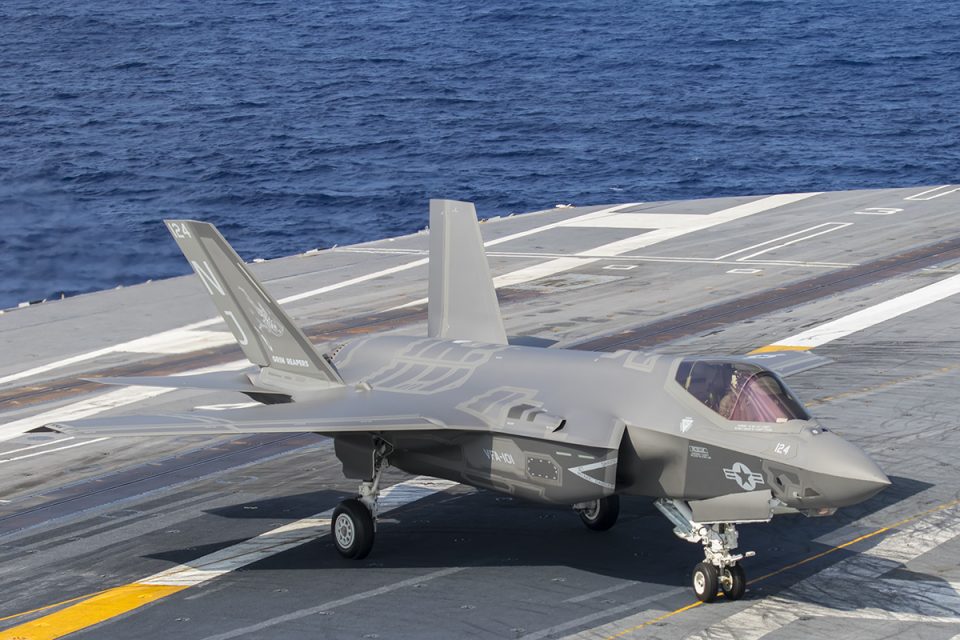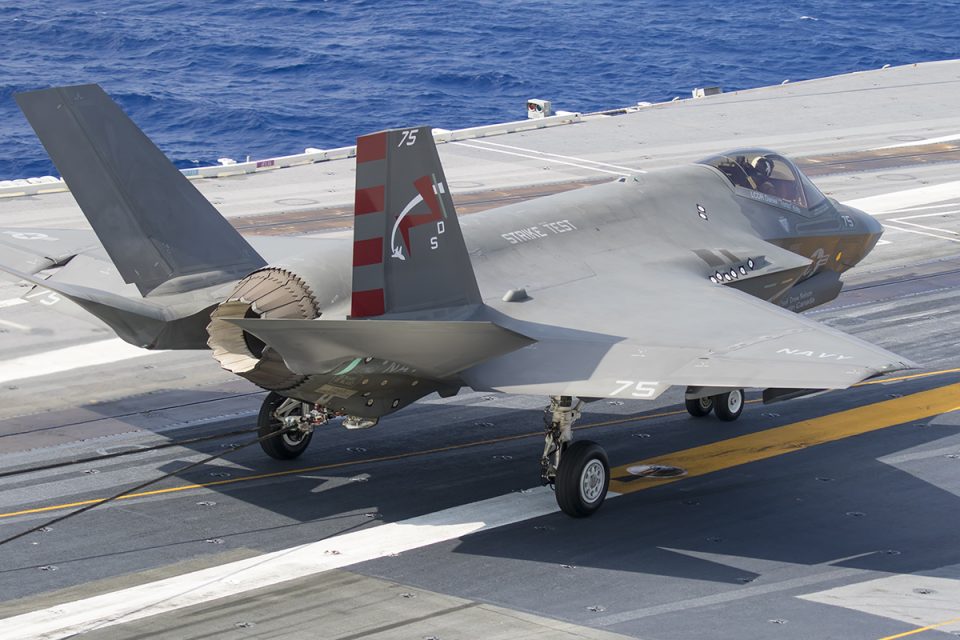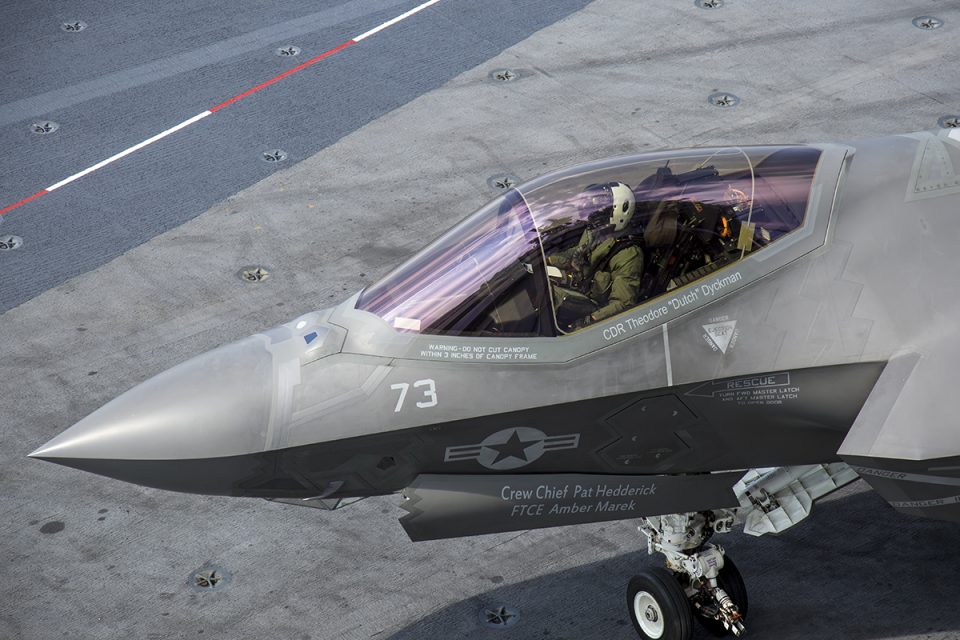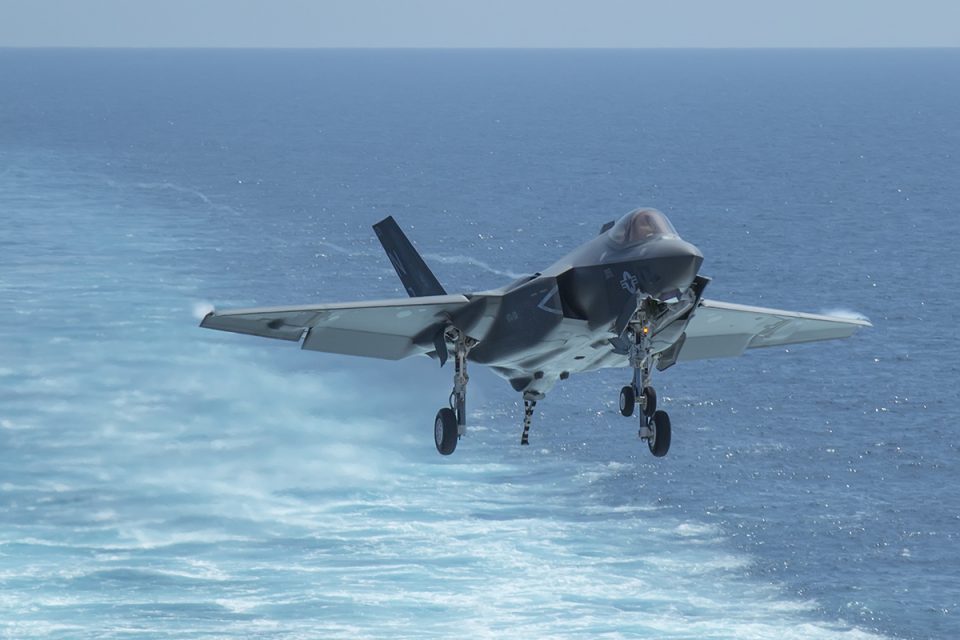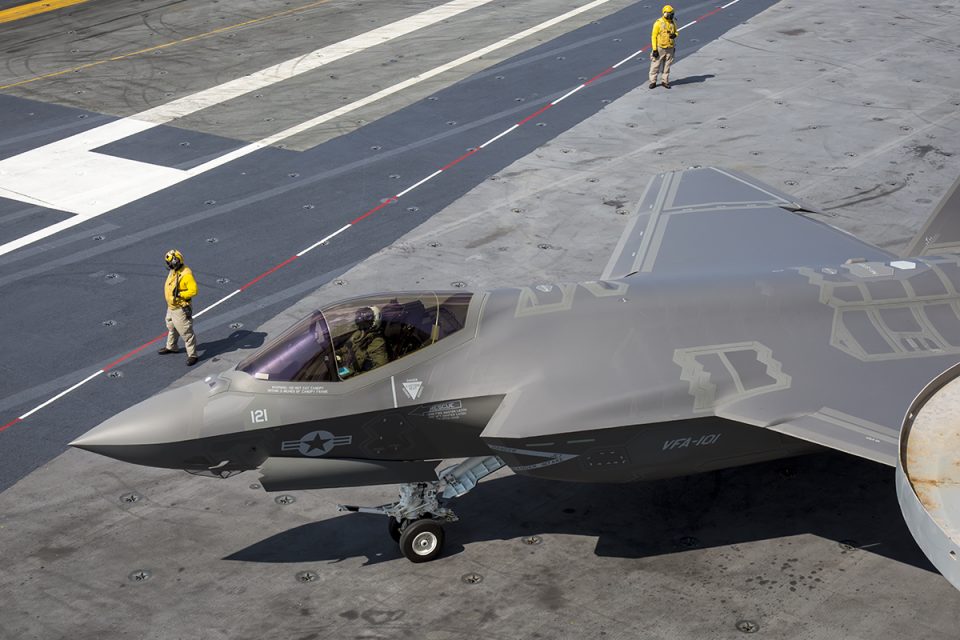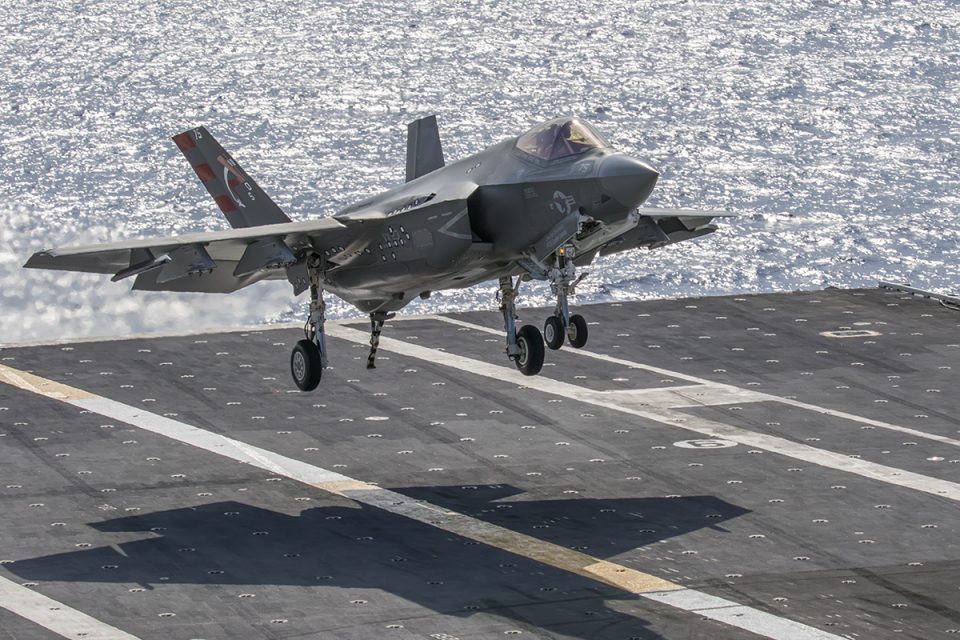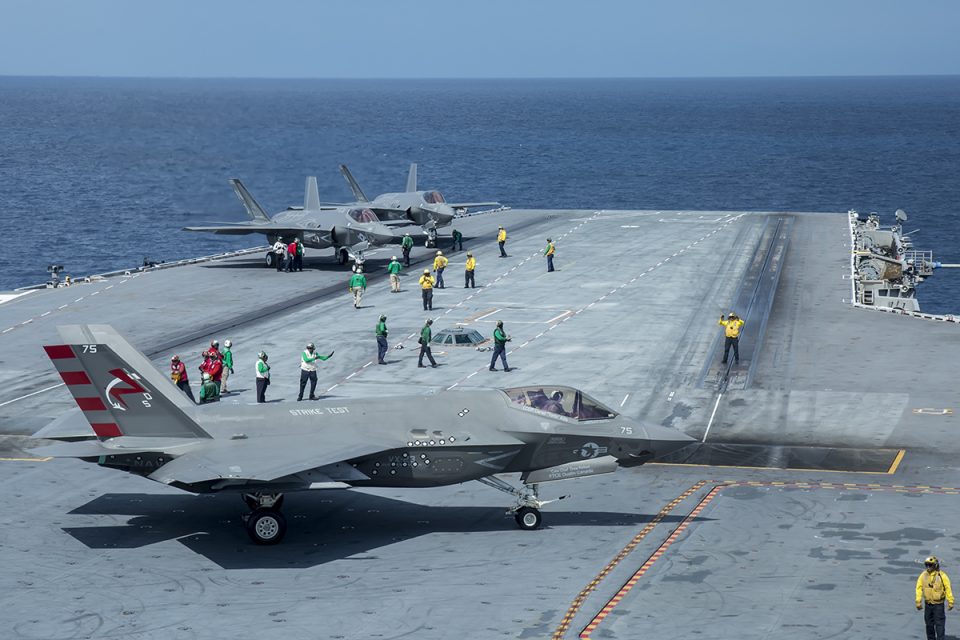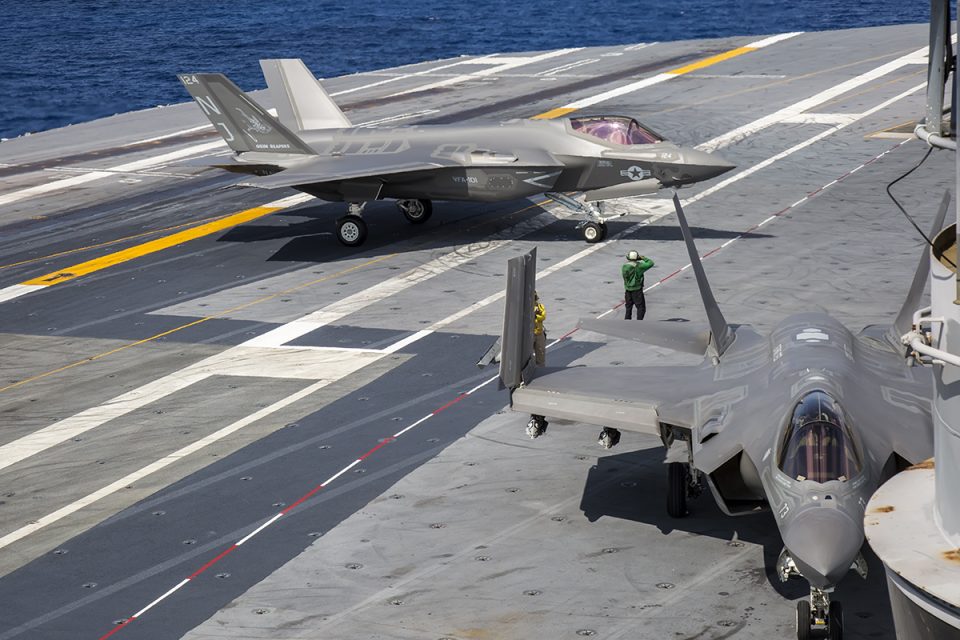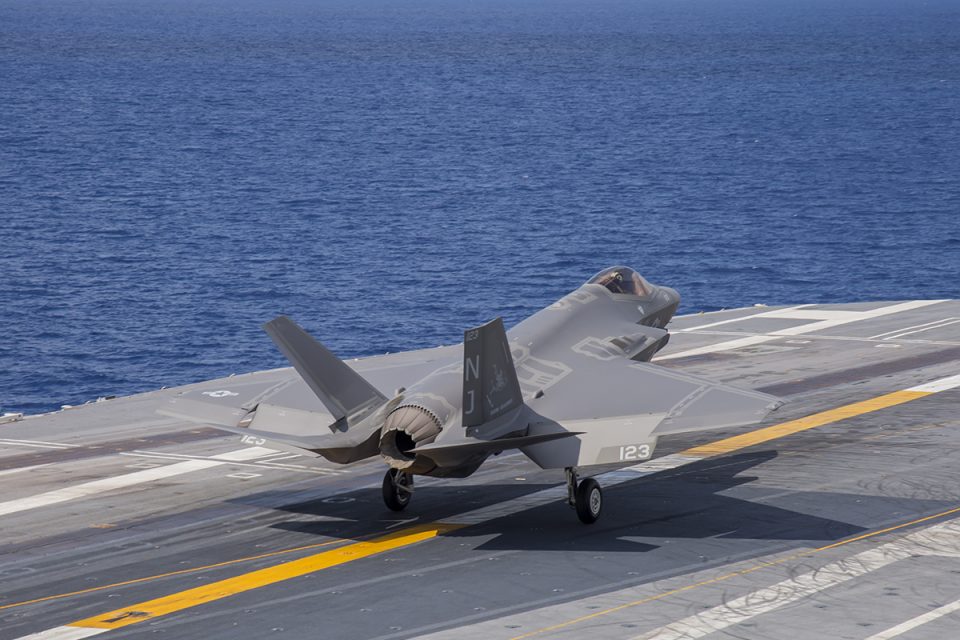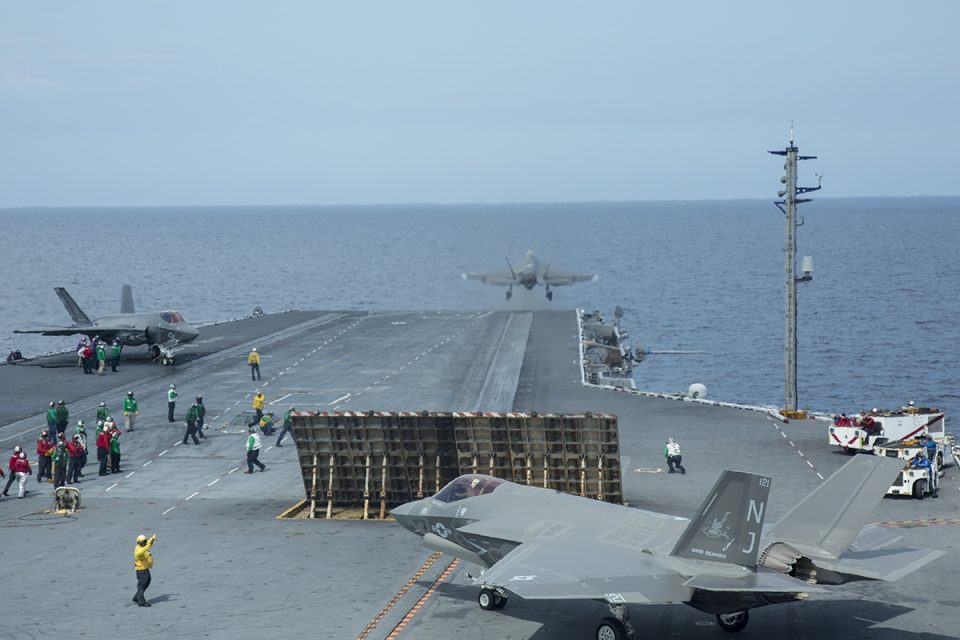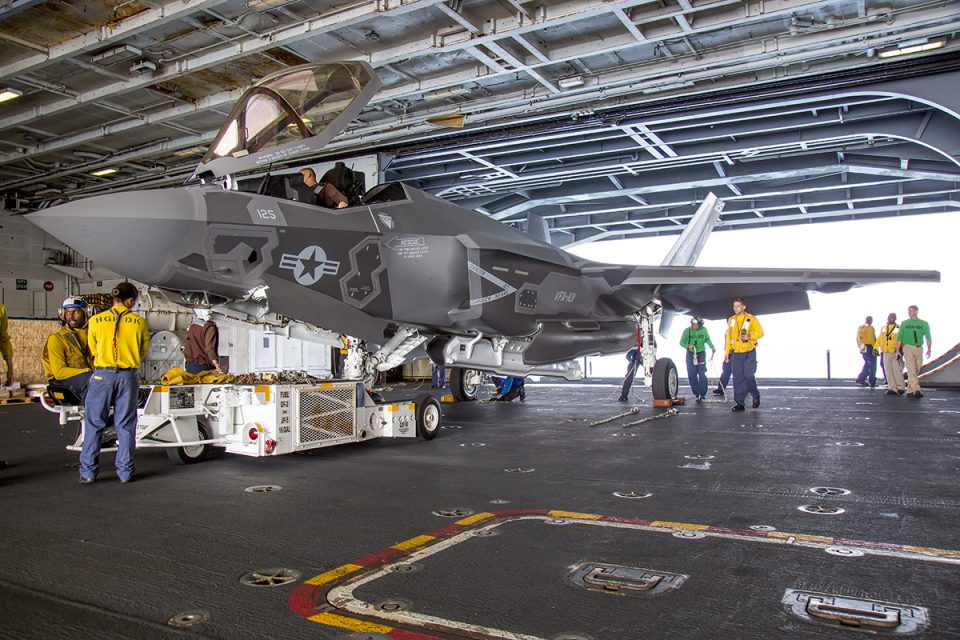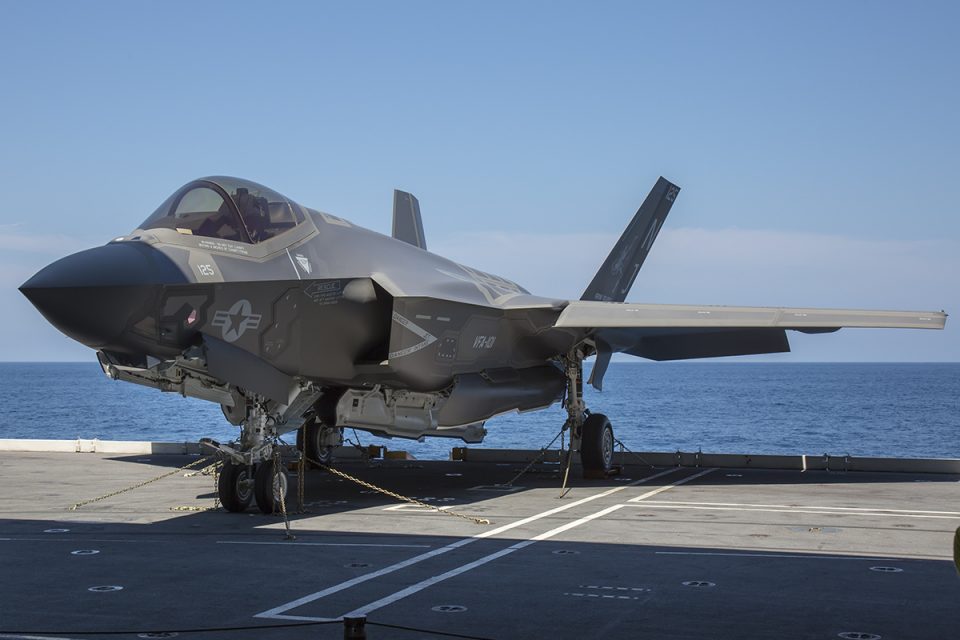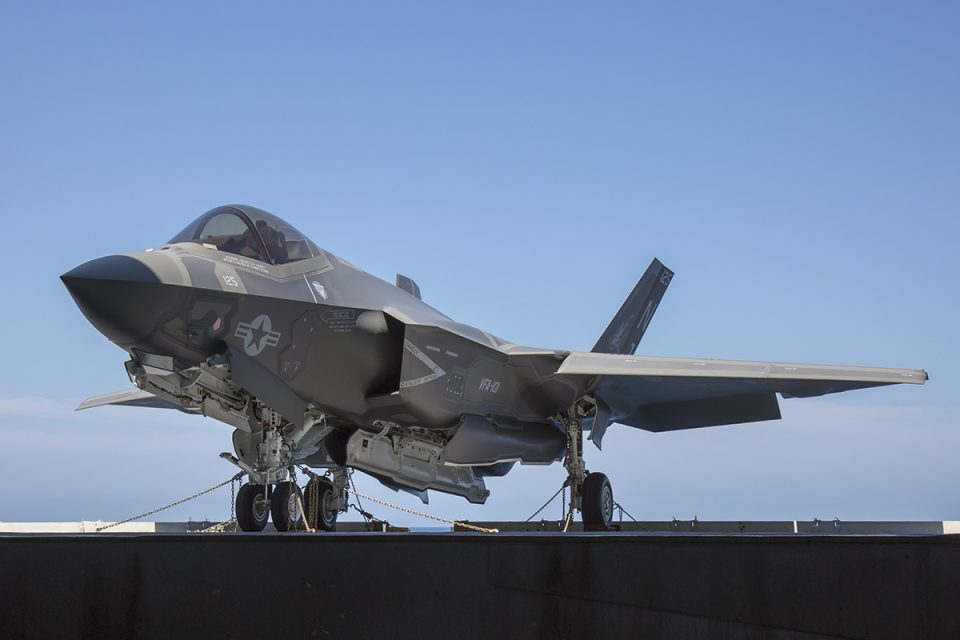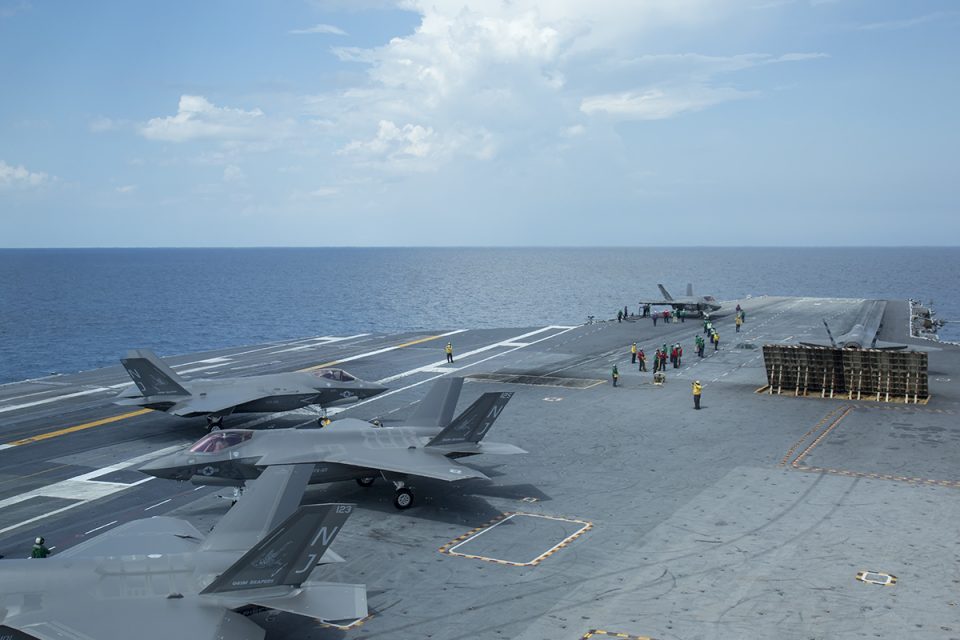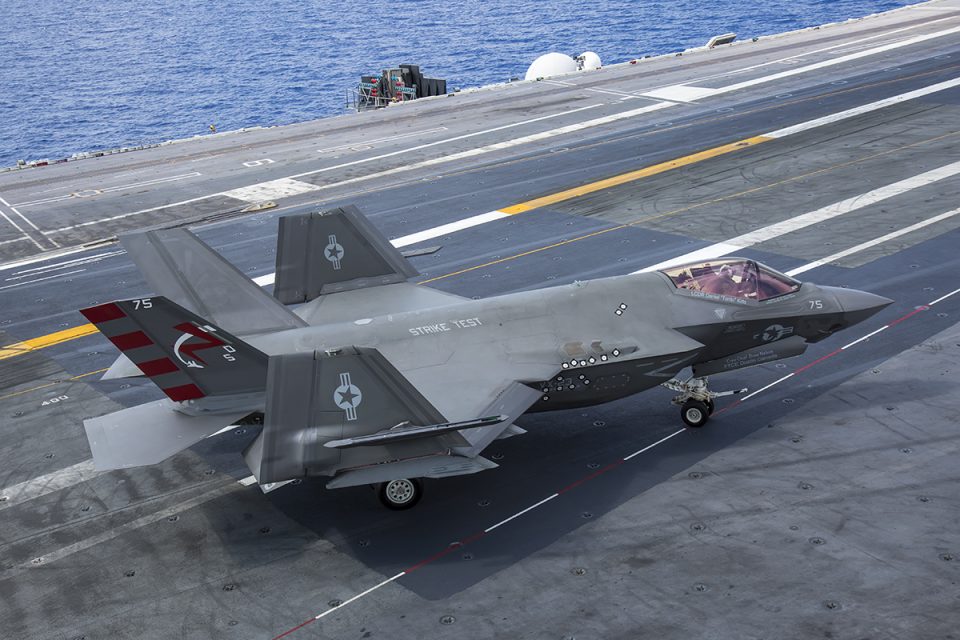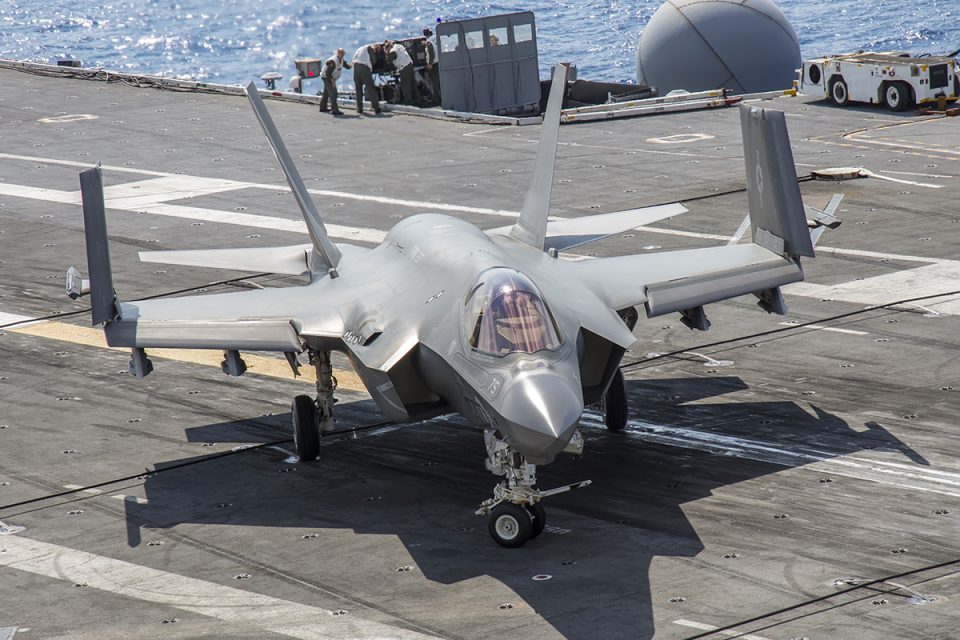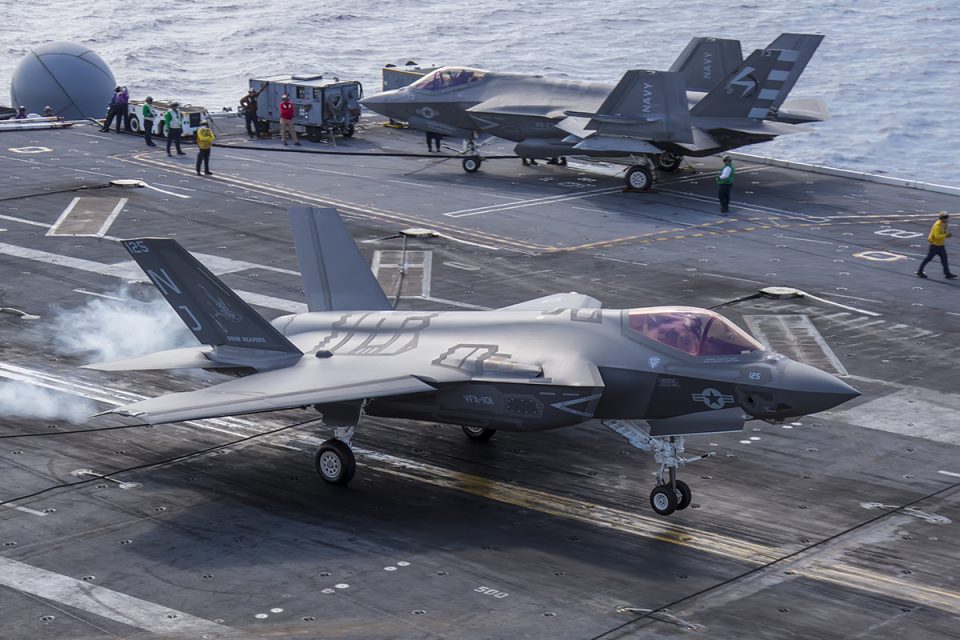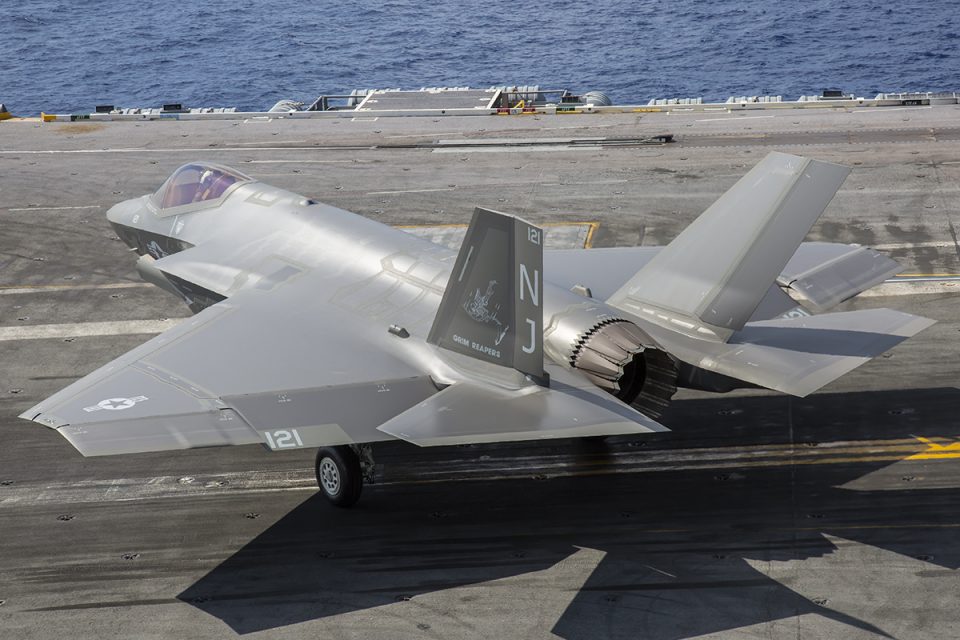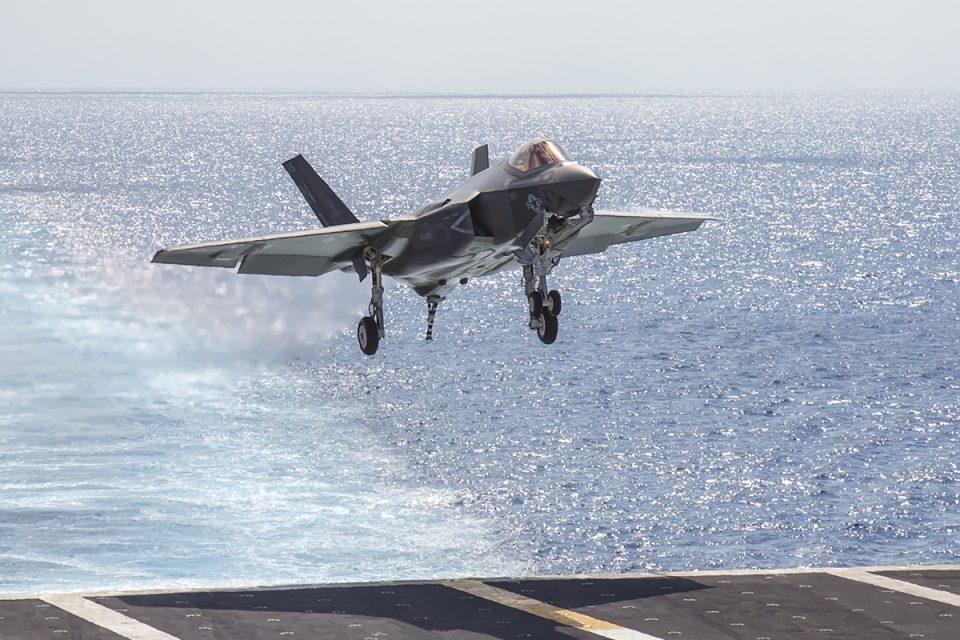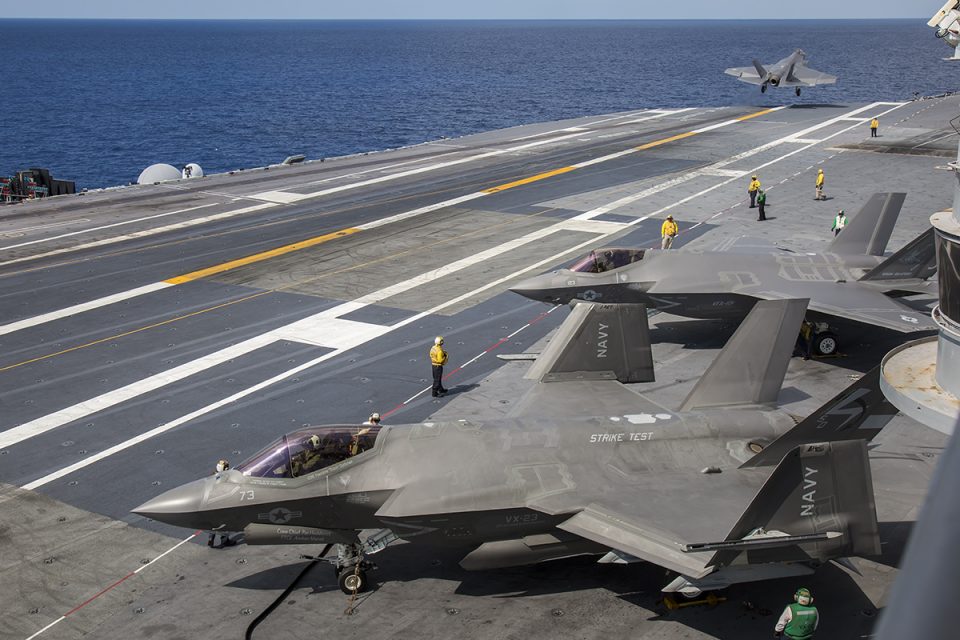2016-08-21 By Todd Miller
The USS George Washington (CVN-73) is hosting the F-35C in its final Developmental Testing cycle (DT-III) Aug. 14-23.
However, for a few of those days the two VX-23 “Salty Dogs” F-35Cs from NAS Patuxent River were joined by 5 F-35Cs from VFA-101 “Grim Reapers” out of Eglin AFB.
The 7 F-35Cs gathered on the deck of the USS George Washington represented the largest carrier contingent of F-35Cs onboard a large deck aircraft carrier to date.
Media were hosted on the USS George Washington August 15 to observe the carrier qualifications at the onset of DT-III. All pilots embarking must perform a number of “cats” and “traps” prior to executing the specific tests involved with DT-III.
DT-III is focused on a number of issues:
- Validation of the aircraft’s flying capabilities with full inert internal and external stores (up to 4 GBU-12s and two AIM-9X on external hardpoints);
- Handling tests with asymmetrical loads;
- Testing for maximum weight launches at minimum power; evaluating all of these in a variety of wind and sea conditions.
As explained by Tom “Briggo” Briggs ITF (Integrated Test Force) Chief Test Engineer, there were additional minor tests to run through, such as ship borne evaluation of minor adjustments made to control laws (based on previous DT testing), and night launches to verify the Gen 3 helmet performed as desired.
Briggs made clear that the testing is to prepare the aircraft launch and recovery bulletins (ALB/ARB). These are the operating guides the Navy will utilize to determine the appropriate launch and recovery parameters for the aircraft given weights and conditions. These bulletins will ensure the aircraft can safely launch with the desired loads to complete assigned missions.
Complete ALB/ARBs will enable the F-35Cs to be very combat capable as they reach IOC utilizing the Block 3F software.
DT-III is a significant milestone for the F-35C program and represents the progression towards US Navy IOC somewhere between August 2018 and Feb 2019.
It was all business as planned. Media probed for human-interest stories from the cadre of pilots on board: “What was it like, after all the simulator hours and practice landings at the airfield to actually land on the ship?
From pilots who had 50 traps with the F-35C to those who had just realized their first – they struggled to provide any other answer; “no drama, no surprise, performed as expected, very vanilla, pretty straightforward.”
No news.
“Any issues moving 7 F-35Cs around the deck at once, or reliability issues?”
No news.
Though not officially part of DT-III, the Grim Reapers of VFA-101 put the state of the F-35C program in context – and made news of their own. VFA-101 represents a cadre of instructors and strike fighter tactics specialists who took this opportunity to carrier qualify so they can prepare the instructor syllabus for the F-35C.
12 VFA-101 pilots with 5 F-35Cs completed their carrier qualifications (CQs) in just over 1.5 days. That is, as Capt. James Christie of VFA-101 described, 10 landings and 2 touch and goes each – 120 cats, 120 traps and 24 touch and goes.
As U.S. Navy Commander Ryan “Flopper” Murphy, F-35 ITF Lead said: “the greatest satisfaction was to watch the fleet (VFA-101) start to utilize the aircraft.
After all, that is the point of everything we are doing, all the years of work; to equip and empower the Fleet with the F-35C.”
After observing VFA-101 for a few hours, it is clear the equipping and empowering are well underway.
Simultaneously the 5 VX-23 pilots performed their CQs.
Suffice it to say, the F-35Cs on board were very busy, and from an observer’s perspective, landing and launches were very frequent. There were instances of hot refueling, with pilot changes during refuel and the aircraft cycling back for more CQs.
As VX-23 F-35C pilot Ted “Dutch” Dyckman explained, everybody completed their CQs faster than with the Hornet. The additional fuel on the F-35C, the ease of landing due to Delta Flight Path mode, along with the aircrafts reliability all played a part in the accelerated CQs.
The innovative “Delta Flight Path” mode that is engaged on approach alters the control laws, setting auto throttles and maintaining the optimal 3-degree glide slope to landing. This approach makes the pilots job landing on the carrier much easier, and they were hitting the desired 3 wire almost 100% of the time.
Any wave-offs were driven by deck activities – not derived from within the aircraft. Delta Flight Path utilizes the flaps to add or decrease lift during approach so as to maintain the glide slope. Observers can see tremendous amounts of flap adjustments on aircraft approach to the deck – these are all controlled by the computer to provide the pilot what they want – glideslope to the deck.
The Super Hornet and Growler control laws are being modified to feature the same Delta Flight Path in an initiative called “Magic Carpet.”
https://www.sldinfo.com/navair-magic-carpet-innovation-for-the-f-18-fleet/
Once Delta Flight Path is fully integrated on the F-35C, F/A-18E/F & EA-18G the efficiencies created will make a profound, operational impact on naval aviation. Numerous pilots identified the benefits provided by Delta Flight Path; safer, less stressful landings on board; pre-embark training cut by as high as 50%; more time available to focus on tactics and missions; reduced wear and tear on aircraft; fuel savings; fewer “tankers” required in the air during recoveries and more.
USMC Major Elroy Northam, a pilot with VX-23 extoled the value of the F-35 in the battlespace as a stealth platform with an advanced sensor suite that will push its way to the forefront of the battlespace, gather all kinds of information as to what is out there, quickly identify “red or blue,” and push it out throughout the force including to legacy aircraft.
The information will provide an unparalleled situational awareness (SA), and the guy with the best SA usually wins.
Recently appointed to the new position, Director of Joint Strike Fighter Fleet Integration, Rear Admiral Roy “Trigger” Kelley was on the USS George Washington for DT-III. Kelley will direct the F-35C program towards IOC.
Given 70% of the world is covered by water, the US Navy-Marine Corps team can expect to be on the frontlines of any potential battle.
Kelley is excited about the capability the F-35C will bring to the Fleet; first day access into contested areas that host sophisticated air defense systems; the ability to utilize stealth and sensors to define the battlespace combined with advanced command and control capabilities that will empower the entire fleet.
The F-35C and associated technologies (Delta Flight Path) will revolutionize Fleet capabilities, particularly when seen in context of the evolving US Navy “kill web” approach. The information gathering and sharing network consisting of the F-35C, P-8A, MQ-4C, Aegis and others will be a foundation for the maritime services operating in the extended battlespace.
Once DT-III is finished the ITF will look forward to DT-III with the F-35B in October, and then close the loop on additional verification of structural load testing on the aircraft. It is expected that their work in this capacity will wrap up the summer of 2017.
For Briggs, (recognized as the 2015 Test and Evaluation Lead Tester) it is hard to put into perspective an effort that has spanned over a decade and a half. One can feel the professional sense of pride he takes in what is being accomplished by the team including the ITF, Lockheed Martin, the USS George Washington, USMC, US Navy and others.
170 personnel from Pax were on the carrier to support the testing, and many more back on land that have been working tirelessly for many years to make it all happen.
DT-III is a significant milestone, and it is clear the US Navy is now tracking very quickly and methodically to a very capable IOC.
Second Line of Defense would like to thank the following for their support: Sylvia Pierson, F-35 ITF/JPO PA; CDR Dave Hecht, Naval Air Force Atlantic PAO; Capt. Timothy Kuehhas, CO USS George Washington; and the many supporting PAOs on and off shore, pilots, engineers, and C-2 Greyhound crews. The entire US Navy team performed as professional, gracious hosts.
Editor’s Note: The Marines have been operating the B for more than a year after IOC and are getting ready to take their first combat squadron to the Pacific next year.
According to one senior Naval aviator, although the Navy has been perceived to be slow on the uptake on F-35, he believed that a rapid learning curve will be driven by the integrated air wing.
Question: The Navy is the last service to acquire the F-35 and has been widely perceived as dragging its feet and providing significant opposition to acquiring the aircraft.
Does this mean that the roll out of the culture changes (of the sort you are talking about) will see a slow cycle as well?
CDR Murphy: I do not think so.
“There has been a barrage of literature out there, which has not always painted the aircraft in a favorable light, and our carrier pilots read that literature.
“But, as the cadre of pilots grows and the aircraft makes its way to decks of carriers, you will see significant change rapidly.
“We operate air wings; meaning that when a new air system comes to an air wing, the entire air wing is affected and its culture changed.
“And, since the air wing trains together and deploys together, the F-35 will become ingrained as part of that air wing very rapidly.
“Other Navy air wings will look at this experience and competitively seek to be as good or better than the last air wing that operated the F-35.
“Peer pressure is a powerful learning tool.”
We would add as well that Marines are naval aviators and are flying the C as well as the B.
This point is often not realized outside of the naval aviation community but is a key plank in shaping capabilities necessary to prevail in the extended battlespace.
https://www.sldinfo.com/the-f-35-learning-curve-the-view-from-pax-river/
For our Special Report published earlier this year on lessons learned at Pax River, see the following:
After visiting Fallon we published a report as well on the future of Naval Aviation, which can be found here:
https://www.sldinfo.com/the-evolving-future-for-naval-aviation/
The slideshow highlights photos taken by Todd Miller with the inclusion as well of photos taken from the deck by US Navy photographer as well.


